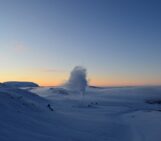
Fires are a common and often natural worldwide phenomena, that are often integral to the lifecycle of certain land-based ecosystems. Despite this, frequent or unusually intense fires can have significant effects on plant productivity, plant community composition and root properties. Although many trees have evolved to grow in fire prone areas, they usually have certain adaptations to help them survive natural fires, such as a thicker bark to protect the trunk and limbs from burning, fire activated seeds and cones, and large roots systems that sprout new trees after the fire passes. However, as the intensity and duration of fires increase, the chance of wildfires killing even trees that are approaching maturity also increases.
In this photograph by Anna Kühnel of a section of forest along the Merced River in the Yosemite National Park, burned in a wildfire called the Meadow Fire in 2014, you can see the fire did not only burn the forest vegetation, but also some of the tree roots, which left large holes in the soil. Tree death in a fire just because of the roots being burned is uncommon, and is most often combined with the fire killing the tree through the trunk and the crown (the top of the tree) or other issues, like the roots being weakened by drought. However, if fires last long enough or burn hot enough for the high temperatures to conduct through the soil, a wildfire can kill even mature trees by burning their roots.
As well as impacting on the plants themselves, wildfires also impact the soil in the areas affected too. In a study published in SOIL journal, researchers found that as the intensity of the fire (measured by the temperature) increased, the carbon and nitrogen present in the soil decreased, as the thermal effects of the fire affected the soil’s organic matter. This can have long term effects on the quality of topsoil necessary for new plants to grow and the loss of a soil’s organic matter can also increase the likelihood of soil erosion.
As with all other aspects of life on the planet, the effects of climate change can be felt with wildfires too, as even natural fires are happening more frequently, are larger and more severe as each year passes. Evidence also shows that ‘fire seasons’, the periods of the year when fires are expected to happen, is getting longer, meaning that large scale, high intensity wildfires are likely to continue to increase.
Description by Hazel Gibson, EGU Communications Officer.
Imaggeo is the EGU’s online open access geosciences image repository. All geoscientists (and others) can submit their photographs and videos to this repository and, since it is open access, these images can be used for free by scientists for their presentations or publications, by educators and the general public, and some images can even be used freely for commercial purposes. Photographers also retain full rights of use, as Imaggeo images are licensed and distributed by the EGU under a Creative Commons licence. Submit your photos at http://imaggeo.egu.eu/upload/.




